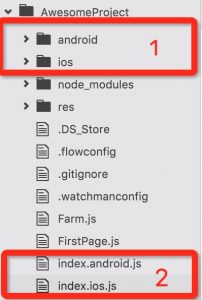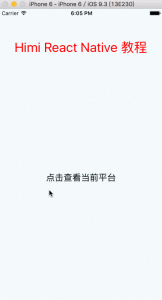本篇介绍两个细节:
1. 关于如何将index.android.js 与index.ios.js统一管理起来。
2. Platform 组件的简单介绍与使用
一:将index.android.js 与index.ios.js统一管理起来。
由于React本身就是跨平台的,但是创建的React项目总会有各自不同的程序入口文件,如下图展示目录结构:

标识1:这里是两个平台的项目文件夹,这里一般就是针对各平台不同配置、嵌入第三方插件等专属平台相关设置与添加的地方。
标识2: React 在不同平台调用的不同入口文件。
那么正常情况下,我们只要不涉及到某个平台独有的特性代码、组件或插件等,我们就完全没有必要走两个不同的入口。否则在Android上运行可能index.ios下运行的代码段还要拷贝到index.android里,反之亦然。
因此我们可以新建一个组件class 让俩平台共同显示这个class,就可以避免这种来回拷贝浪费的时间。
1. 假设我们新建了一个叫Main.js的组件Class
2. 然后index.ios.js如下:
importReact, { AppRegistry, Component, View, } from 'react-native'; importMainfrom './Main'; class AwesomeProject extends Component { render() { return (<Main/>); } } AppRegistry.registerComponent('AwesomeProject', () => AwesomeProject); 3.index.android.js如下:
importReact, { AppRegistry, Component, View, } from 'react-native'; importMainfrom './Main'; class AwesomeProject extends Component { render() { return (<Main/>); } } AppRegistry.registerComponent('AwesomeProject', () => AwesomeProject); 这样统一显示Main组件的内容,以后不论在android还是ios平台都可以完美兼容,小细节,估计大家一看就懂。
二. Platform 组件的简单介绍与使用
有时候我们会区分平台做一些处理,比如充值、适配问题、接入第三方SDK或与原生平台组件进行交互等等。
这时我们就需要 RN提供的 Platform 组件~ 使用很简单,就不多赘述了。
示例:
代码段1:(导入Platform组件)
importReact, { ... Platform, ... } from 'react-native'; 代码段2:
estAlert(){ if(Platform.OS === 'ios'){ Alert.alert('测试当前平台', 'iOS平台'); }else if(Platform.OS === 'android'){ Alert.alert('测试当前平台', 'Android平台'); } } render() { return ( <Viewstyle={styles.himiViewStyle} > <Text style={styles.himiTextStyle}>HimiReactNative 教程</Text> <Viewstyle={styles.himiViewStyle}> <TouchableHighlight underlayColor='#f00' onPress={this.testAlert.bind(this)} > <Text style={{fontSize:20}}>点击查看当前平台</Text> </TouchableHighlight> </View> </View> ) } 主要看 testAlert 的函数中的内容,通过Platform.OS获取当前平台类型与android/ios做比较即可得知。
运行效果如下(点击查看动态图):

来自: http://www.himigame.com/react-native/2260.html











![[HBLOG]公众号](https://www.liuhaihua.cn/img/qrcode_gzh.jpg)

